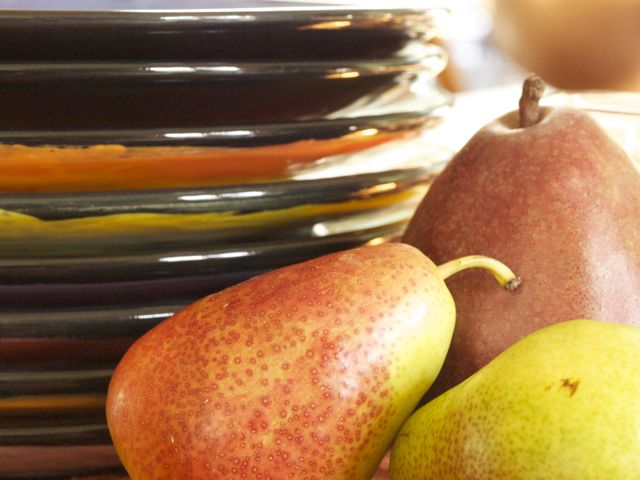
reference-image, l
(article, Ellen Jackson)
[%pageBreakSettings nobreak=true] p(blue). Editor's note: Want to win a copy of Dolores Custer's new book, Food Styling: The Art of Preparing Food for the Camera? Leave a comment about your favorite tried-and-true tip for entertaining at the end of this article. On December 23 at noon PST, we'll draw two winners randomly from among all the commenters. Good luck, everyone! Pumpkins in May. Peaches in December. As I've learned on the job, professional food styling seldom begins with ingredients that are fresh, organic, or responsibly sourced. Sometimes they’re not even fully cooked. [[block(sidebar). h1.Featured recipe]] I often joke that styling food for photographic purposes has nothing to do with the food we actually like to cook and eat. Rather, the gig has everything to do with setting up expectations for an imagined gustatory experience to come. We eat with our eyes first, after all. Food displayed with care creates visual appeal, influencing our perception of taste even before we pop a morsel into our mouths. But real food is another matter. You can trick the eyes, but not the belly. A fantastic dinner party, for example, is built upon quality ingredients and good kitchen skills. How the meal looks is less important. Or is it? In food styling, a mouthwatering image relies heavily on props. A plate of food can be made to look infinitely more delicious when lovingly plated, thoughtfully garnished, and presented on a table laid with crisp linens, fresh flowers, and candles. Taste, in other words, is in the mouth of the beholder. Throw in some jovial conversation and a bottle of good wine, and you’ll feel like Ina Garten in no time. Here are eight essential tips culled from my experience as a food stylist. Keep them in mind, and they'll help make your holiday dinners not just tasty, but memorably delicious. After all, both food styling and entertaining have the same goal: creating a sense of pleasure. [[list(culinate8). #(clear n1). Lighting. When planning a dinner party, it’s unlikely that lighting tops your list of important details, but on set — whether in a photography studio or on location — it’s crucial to conjure the right experience. The soft glow of candles, ambient light from adjoining rooms, the warmth and flicker of a fire, festive strings of twinkling lights — each goes a long (and different) way to setting the scene that ultimately enhances what’s on the plate. #(clear n2). Props. Once you've got the right ambiance, consider the story you want to tell. Look to the food and plates to suggest additional props. In the case of a dinner party, these props are generally choice of linens (not just napkins but tablecloth vs. placemats vs. table runner vs. bare wood table), flowers, and/or a centerpiece. You can go simple, with a bowl of seasonal fruit and nuts as a centerpiece, or get wildly creative. I once did a pear-themed holiday shoot, for example, featuring a tiny sleigh pulled by a Bosc pear with earmuffs and a scarf. A bistro-style French meal, on the other hand, might warrant a small chalkboard propped on the table listing the evening's menu. #(clear n3). [%image reference-image float='clear right' width=350 caption='Pears and plates, also known as "props."']Plates. Putting food on the proper plate means considering the plate's shape, color, and size (the volume it holds), as well as how different foods relate to one another on the plate. Start with complementary colors (red peppers in a green bowl, clementines in a blue bowl, purple eggplant in a yellow bowl). An Indian feast with rice, dal, meat, and chutneys might call for a dozen colorful bowls or a traditional thali platter. A meal served on a banana leaf says, “Use your hands!” My husband’s all-time favorite meal included hand-thrown pottery for each of 27 courses of a traditional kaiseki meal. #(clear n4). Dishing up. Your table is set, but now you've got to choose how to serve the food: Formal plating in the kitchen? A DIY buffet? Family-style serving from communal bowls at the table? Choreograph your parties by suggesting the interaction between guests. Formal service calls for restraint in styling and in your guests’ expectations. Likewise, a casserole straight from the oven to a trivet on the table says, “Dig right in.” #(clear n5). Focal points. Stylists arrange edibles so that the eye is drawn purposefully around the items on the plate to the main event, whether that's a juicy serving of turkey or a cloud of meringue. The goal of every food stylist is to make that item “pop.” (Yes, that's the official term in the biz.) Remember the principle of focal points when you're plating a dish or arranging a serving bowl. #(clear n6). Contrast. A plate of food without texture, no matter how delectable, is a missed opportunity to add interest to the meal. Just as there are complementary colors, texture pairs keep your senses guessing. Think consistency, shape, and mouth feel: smooth lemon curd in a crunchy oatmeal crust, fried sage leaves on squash purée, or creamy goat cheese rolled in flaky sea salt and cacao nibs. #(clear n7). Music. In work as in play, music has the ability to alter mood and energy. So choose your playlist accordingly: for example, light and bright for cocktails, more mellow for the meal itself, and finally peppy for dishwashing. Personally, I like reggae while finishing off a bottle of wine and washing wineglasses. #(clear n8). Guests. Inviting the right number of the right people can be tricky, but it's the key to balance, good conversation, and a mood that celebrates all of the above. Try to invite people from a mix of backgrounds, and keep the guest list small to ensure comfortable chatting. ]] p(bio). Former pastry chef Ellen Jackson is a food stylist and freelance writer who lives in Portland, Oregon.

reference-image, l